|
On September 24, the county board received an update on progress towards developing the county’s climate action plan. Staff recommended seven climate strategies that will serve as a solid foundation for the county to advance a coordinated response to climate change. See the presentation (PDF) for details.
Climate change affects all parts of the county and all residents and businesses. The county’s approach to an impactful climate action plan is to engage residents, listen to how climate change is impacting them, and build support for solutions.
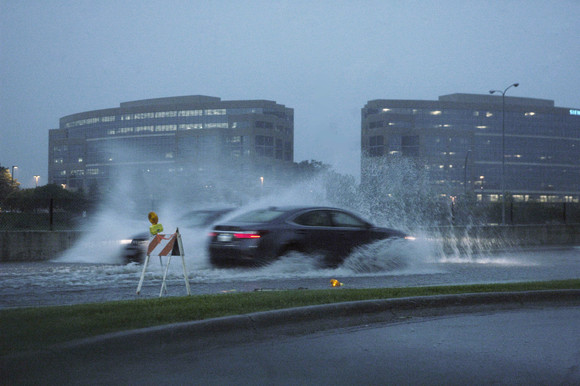
Assessing climate impacts and addressing inequities
Our vulnerability research shows some of the most serious impacts, for example localized flooding and excessive heat, will disproportionately impact people of color, low-income families, and other vulnerable community members. The county will center this work to address these inequities. Our response must also protect our buildings, roads, other infrastructure and natural resources, and the county must continue to deliver services in times of disruption.
To cut greenhouse gas emissions, the county is focusing efforts in ways that align with core county functions and existing priorities – such as investing in transit, planting more trees, and encouraging waste prevention efforts. Finally, we will seek partners to leverage resources and accomplish work that cannot be done in isolation.
Building support and plan approval
The board provided clear direction that climate work is a priority, even in these difficult times. The board wants to see resources align around this priority, and they are interested in supporting greater collaboration among lines of business and with outside partners.
Staff will now shift efforts to conducting broader external engagement to involve community groups, businesses, and foundations. We are also planning online options to engage the broader public on our goals and strategies for climate action this fall and early winter.
Sign up to receive email updates on the county’s climate action plan.
Staff aim to share a draft of the Climate Action Plan with the board by the end of 2020. Board adoption of the plan, which would include a formal public comment process, would occur in 2021.
For more information, contact Rosemary Lavin at rosemary.lavin@hennepin.us.
Environmental education grants awarded
Environmental education grants were recently awarded to 20 organizations totaling more than $300,000. The grants provide training, support, and funding to organizations to implement projects that engage residents to protect and improve the environment.
Grantees have creative and engaging activities planned
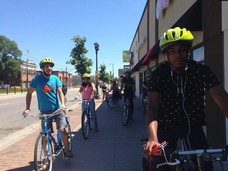
The program offers two types of grants.
Through the environmental action grants, adult audiences will be engaged in creating personalized climate action plans, conserving energy, signing up for renewable energy programs, recycling, reducing waste, repairing clothing, and buying used.
Some activities supported by the youth environmental education grants include learning about nature, developing job skills in green infrastructure, participating in outdoor recreation, bicycling for transportation, reducing waste, composting, protecting pollinators, exploring climate solutions, creating art about environmental protection, and educating the community about using green cleaners.
|
Grants will have broad reach and engage diverse audiences

The grants awarded will engage more than 6,500 residents in becoming environmental stewards and taking action to protect the environment. These projects are expected to reach more than 200,000 residents with environmental messages. Of the 23 projects, 21 projects engage Black, Indigenous, or communities of color and residents that live in areas of concern for environmental justice.
Learn about the grants awarded.
For more information, contact Patience Caso at patience.caso@hennepin.us.
|
Healthy Tree Canopy grants awarded
The county recently awarded 20 Healthy Tree Canopy grants totaling about $379,000. The grants will help combat threats to trees from invasive insects and diseases, promote the development of a more diverse, resilient, and equitable tree canopy, and support efforts to educate the public on tree care and the importance of trees.
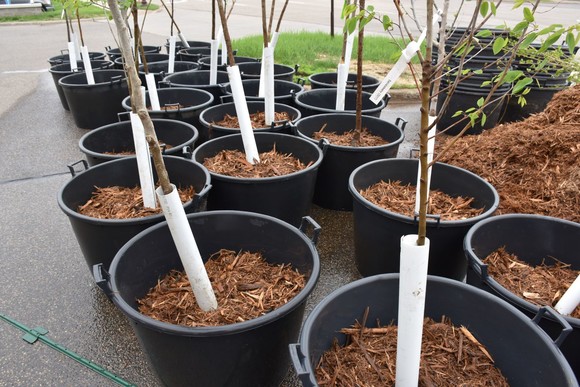
Increasing the benefits that trees provide
More than 1,000 trees will be planted through the grant projects, increasing the benefits that trees provide throughout the county. Trees improve air quality by absorbing fine particulate matter and other pollutants, and they protect water quality by slowing down and infiltrating stormwater runoff. Trees also provide shade, reduce the urban heat island effect, reduce stress, and increase property values.
Prioritizing grants that help address disparities
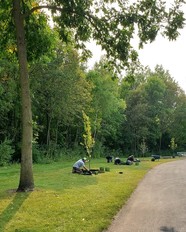
The grants will improve livability by planting trees in neighborhoods throughout the county experiencing disproportionate amounts of economic, environmental, and health disparities. Grants were selected in part using the county’s tree planting prioritization map, which factors in both environmental and demographic data to identify areas that have lower tree canopy and higher need. Most of the grant projects are within moderate and high priority planting areas.
Learn about the grants awarded.
For more information, contact trees@hennepin.us.
|
Food shelves and meal programs receive fridge and freezer grants to increase food rescue
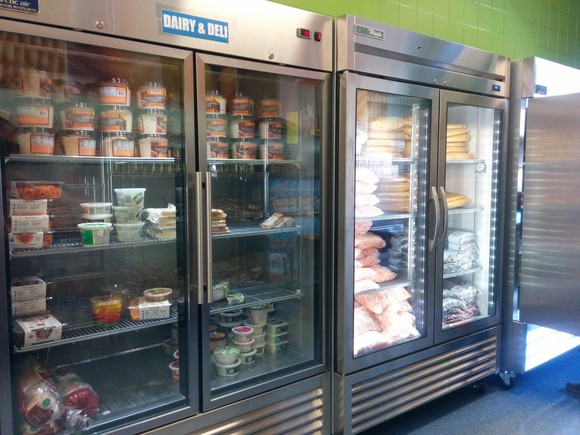
Food shelves in Hennepin County are seeing unprecedented demand for help. Recently, three organizations received grants from Hennepin County to buy freezers or fridges to increase their capacity to rescue food that would otherwise go to waste.
Three freezers will help Pillsbury United Community’s three locations in Minneapolis distribute more meat, rescue and repackage prepared meals, and freeze produce grown on their farm. An additional fridge and freezer will allow New Creations Ministries in Minneapolis to open more than one day a week and more fully utilize its rescued food. Community Emergency Assistance Programs (CEAP) in Brooklyn Center is getting an additional freezer to use for its curbside program so volunteers can get food to families while maintaining social-distancing protocols.
Grants are available to businesses and organizations to increase capacity (rather than just manage what has already been coming in) and to help capture food that would otherwise go to waste. The grants cannot be used to replace existing freezers, and the freezers must be Energy Star certified.
See the bottom of page 5 of the business recycling grant guidelines (PDF) for more details. Hennepin County can help develop grant proposals and provide technical assistance. Applications will be accepted until late November.

Reuse retailers in Hennepin County are invited to join a free marketing program being offered by Hennepin County called Join the Circle. The program aims to increase awareness of the benefits of buying used among consumers and encourages them to shop at local reuse retailers.
Participating retailers receive:
|
- Exclusive trainings and resources related to merchandising, marketing, social media, operations and more.
- Marketing initiatives developed and deployed by Hennepin County to increase awareness and drive new customers to your store.
- Access to Join the Circle content that you can share with existing and prospective customers to deepen your relationship with them.
- Inclusion in a reuse retailer community that shares advice and support among members.
Individual consumers interested in buying used can sign up to Join the Circle and receive valuable waste reduction tips, discounts, and exclusive previews for sale events sent right to your inbox.
For more information or to join, contact Kristin Pierskalla at kristin.pierskalla@hennepin.us.
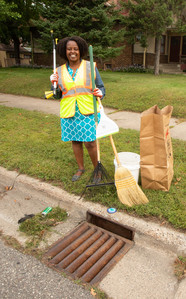
Help stop pollution while staying safe this fall – adopt-a-drain! It takes 15 minutes, twice a month, to sweep up, rake up, pick up the leaves before they go down the drain and pollute local lakes and streams.
Here are quick tips to get you started:
- Get your cleaning gear together. Useful items include a broom, rake, trash grabber, gloves, an orange cone and/or safety vest, snow shovel or dustpan, and a pail or yard waste bag.
- Clean the surface of the storm drain grate and the area around it. Never remove the grate or otherwise attempt to clean inside the catch basin. If the drain seems to be plugged or have any problem, contact city staff and they will send workers to address the issue.
- Safety first. During COVID-19, remember physical distancing and wear a mask when others are nearby. Wear gloves to protect your hands and be careful when picking up leaves and trash. You might want to use a trash grabber to collect debris. Consider wearing bright or reflective clothing. Do not stand or crouch on busy streets.
- Separate and dispose of the waste. Sort it into the appropriate bin: recyclables (glass and plastic bottles, cans), yard waste (leaves, grass clippings, sticks, and sediment), and trash.
|
Volunteer in Minneapolis to distribute Adopt-a-Drain flyers
You can help spread the word about the Adopt-a-Drain program by organizing a group of volunteers to distribute door flyers in your neighborhood. This is an easy, fun and physically distant volunteer activity that helps educate people about a few simple steps they can take to improve our natural waters. If you’re interested in volunteering, contact Lane Christianson at lane.christianson@minneapolismn.gov.

Don’t let a valuable resource wash down the drain and pollute our local lakes and streams. Instead, turn it into a resource!
Leaves and grass clipping can add nutrients into your yard or be recycled into compost. Consider these options for managing yard waste.
Curbside pick-up
Curbside pick-up is offered by some haulers. Contact your city or hauler for options. Bag up your yard waste in certified compostable bags.
|
Yard waste drop-off sites
There are four yard waste drop-off sites in Hennepin County open to all residents, while other yard waste sites are only open to residents of certain cities. Note that Hennepin County does not operate a yard waste drop-off site.
Yard waste sites open to all Hennepin County residents - call first for materials they accept, requirements and fees:
Composting at home

To help divert waste from landfills, Hennepin County has grants available for homeowners and developers to deconstruct buildings to salvage building materials rather than demolish them.
So far, nine deconstruction grant projects have been completed and six more projects are in progress. Materials commonly salvaged on projects include light and plumbing fixtures, cabinets, doors and windows, wood flooring, and dimensional lumber. Grantees point to the environmental benefits of deconstruction as the main draw to the program.
Compared to mechanical demolition techniques that use heavy equipment to knock down structures, deconstruction involves carefully dismantling buildings to salvage building materials for reuse. About 85 percent of the materials in a typical demolition or remodeling project could be salvaged and kept out of landfills by using deconstruction.
Homeowners and developers of residential properties can receive up to $5,000 to offset the added costs of deconstruction in participating cities. Learn more about the grants, including eligibility and requirements, and apply online.
|
Recovering valuable metal from the ash created at the Hennepin Energy Recovery Center
After garbage is burned at the Hennepin Energy Recovery Center (HERC) to create energy, the ash that remains is sent to a landfill. But before being buried, the ash is sorted by a company called GEM-Ash to recover metal. The company recovers up to 1.3 million pounds of metal per month, which adds up to about 8 percent of the ash. In addition to creating energy from garbage and reducing the volume of waste sent to a landfill by 75% at HERC, recovering metals further increases the amount of valuable resources that is recovered from the garbage and saves additional landfill space. Recycling the recovered metal saves energy and reduces the amount of natural resources that need to be used to make new products. Read more in the Star Tribune.
Tangletown Neighborhood Association launches textile waste education project

With the support of a Hennepin County environmental education grant, the Tangletown Neighborhood Association is launching a project to raise awareness about textile waste. The project will include a virtual documentary screening about the impact of fast fashion in October, a virtual panel about buying used clothing and donating unwanted textiles in November, and a textile education fair next year. The goals of the program are to encourage people to rethink their clothing choices by limited what they purchase, buying used clothing, and purchasing sturdier clothing that is designed to last. Read more in the Southwest Journal.
|
Litter Be Gone cleanup in Minneapolis
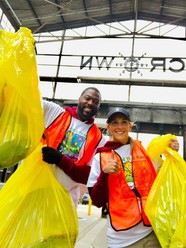
Minneapolis residents are invited to take part in Litter Be Gone, an annual litter cleanup event happening October 1 to 10. Volunteers will pick up litter from their neighborhood streets and sidewalks to prevent it from ending up in storm drains and waterways. To stay safe, individuals, families, and small groups of neighbors are encouraged to clean up their own blocks anytime during this 10-day event.
It’s easy to participate. Volunteers need only a pair of gloves and some plastic bags for collecting littered trash and recyclables. Volunteers can use their own supplies or pick up free gloves and bags at a Litter Be Gone supply hub on Saturday, October 3, 2020.
Volunteers are asked to share their results, including the number of volunteers, bags collected, and blocks cleaned, to add to the community-wide impact. All volunteers who share their results will get free access for 12 months to the Chinook Book app.
|
Fall is a time of great transition in Minnesota. The leaves turn, temperatures drop, birds begin their migrations, and harvest season gets underway.
With many of us continuing to spend more time at home and in nature, this is a great opportunity to pay attention to phenology - the study of nature’s timing that is influenced by environmental changes, especially seasonal variations. The nice thing about phenology is that you can make observations anywhere, including while visiting a park, walking in your neighborhood, sitting in your backyard, or watching from your window.
Each fall can vary depending on temperature and precipitation. For example, peak fall color in our area is typically between late September and mid-October, but this can vary widely from year to year.
Late September and early October

- Common milkweed pods open and the seeds are carried by the wind.
- Trees are nearing peak fall color, so get outside to see the red, yellow, brown, and orange rainbow of fall!
- The migration of warblers, hawks, and sandhill crane peaks.
- Most bat species in Minnesota migrate south, but bats that don’t migrate go through a short swarming period where they gather together to find a place to hibernate for winter.
- White-tailed deer mating season begins – look for rubs and scrapes on trees and in the soil from bucks.
|

- Turtle crossing alert! Baby turtles are leaving the nest and migrating to their overwintering ponds
- Waterfowl hunting season begins.
- Colder weather brings the first frost of the season.
- Woolly bear caterpillars emerge, and monarch butterflies start heading south.
|
Mid-October
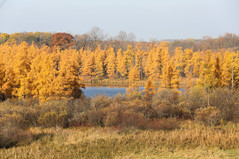
- Tamarack trees – a rare deciduous conifer – turn a smoky gold color. Find tamaracks in swamps where they can get plenty of sun.
- Songbirds continue to migrate. Look for an abundance of migrating robins and cedar waxwings on crabapple trees and notice the return of juncos and fox sparrows. Get out your bird seed and help feed the hungry migrants and winter residents.
- Lake turnover occurs when colder air temperatures cools the surface water of lakes. Since cold water is more dense than warm water, the cold water sinks and the less dense, warmer water rises to the top. This helps redistribute oxygen in the lake, keeping it a healthy habitat for fish.
- Management of invasive species buckthorn is best done in late fall. Keep an eye out for volunteer events!
- Harvest is in full swing for apples, corn, pumpkins, and soybeans.
|
Late October to early November
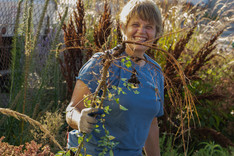
- Leaves have fallen off the trees and gardens are going dormant. Make sure you are managing your yard waste and garden cleanup to protect water and pollinators.
- Waterfowl migration is peaking – listen for the loud calls of geese, ducks, and swans when you are near water.
- Now is the time to plant garlic in farms and gardens.
|
Middle to end of November

- Deer firearm hunting seasons begin.
- Owl species that are common further north may push south due to limited prey. Keep your eyes peeled for a rare sighting of a snowy owl near the metro.
- Lakes and ponds begin to freeze over.
- Frogs and toads have found safe places for the winter to become dormant, hibernating under water, under leaf litter, underground, or in aquatic vegetation.
Learn more about Minnesota fall phenology by getting a Weather Guide calendar, or by checking out the illustrated guide to signs of Minnesota fall on MinnPost.
Learn how to contribute to the collection of phenology data through the USA Phenology Network’s Nature’s Notebook or the Minnesota phenology network.
|
|

























